Gillespie Dam
The Gillespie Dam is a concrete gravity dam located on the Gila River between the towns of Buckeye and Gila Bend, Arizona. The dam was constructed during the 1920s for primarily irrigation purposes. A portion of the dam failed unexpectedly in 1993 during unusually heavy rains.
| Gillespie Dam | |
|---|---|
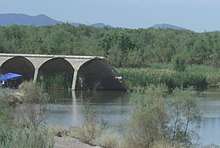 The Gila River flows freely through the breached dam. | |
| Official name | Gillespie Dam |
| Location | Maricopa County, Arizona, USA |
| Opening date | 1921[1] |
| Dam and spillways | |
| Impounds | Gila River |
| Height | 80 feet (24 m) |
| Length | 1,700 feet (520 m) |
| Reservoir | |
| Creates | Gillespie Dam Reservoir (former) |
History
The Gillespie Dam was constructed circa 1920 by a local rancher, Frank Gillespie, to replace an existing structure.[2][3] As the dam was located at an important river crossing that would later become US Route 80, the Arizona Highway Department - the predecessor to the Arizona Department of Transportation - constructed a concrete apron at the foot of the dam to allow for vehicular crossings. As the dam was a simple spillover construction, during times of heavy runoff cars would have to be pulled through the flow by trucks, and during floods could not cross at all.[1]
In anticipation of the formation of the United States Highway System in 1926, the Highway Department commissioned the construction of the Gillespie Dam Bridge, a steel truss bridge just downstream from the dam. The bridge was completed and opened to traffic on August 1, 1927 at a cost of US$320,000 (US$3,950,000 in 2007). The bridge, which was at the time the longest highway bridge in the state of Arizona, was immediately incorporated into the highway system as Route 80.[1] The bridge carried US 80 traffic until 1956 when the highway was decommissioned, devolving to a county highway, thus placing the bridge under Maricopa County care. The bridge was added to the National Register of Historic Places on May 5, 1981.[4]
Failure
The winter months of 1993 saw unusually high rainfall amounts that resulted in record flows through central Arizona rivers and streams, including the Salt River, a major tributary to the Gila upstream from the Gillespie Dam.[5] At approximately 10:30 on the morning of January 9, the dam failed when a segment approximately 120 feet (37 m) in length collapsed into the river. While the precise cause of the failure is unknown, the extreme flooding was almost certainly a contributing factor. The precise size of the flood was not recorded due to equipment failure, but an estimate based upon a high-water mark recorded on USGS equipment yielded a peak flow of approximately 200,000 cubic feet (5,700 m3) per second, corresponding to a predicted 65-year flood, or a flood of a magnitude anticipated only once per 65 years. The previous high, recorded during similarly disastrous floods in 1980, had been 178,000 cubic feet (5,000 m3) per second.[6]
Due to the failure, three underground natural gas lines were exposed and later severed by the floodwaters. The bridge downstream survived, and was deemed safe for travel.[1]
The remnants of the dam remain in place and the area is largely accessible to the public. A small earthen embankment exists to divert water into nearby canals.
Gallery
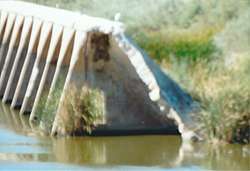
- The ruins of the Gillespie Dam.
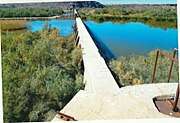 Different view of the dam.
Different view of the dam.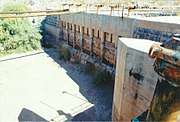 The Gillespie Dam
The Gillespie Dam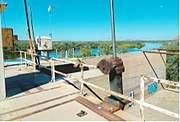 Rusted equipment on the dam.
Rusted equipment on the dam.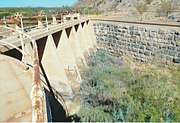 More rusted equipment on the dam.
More rusted equipment on the dam.
- The historic Gillespie Dam Bridge was built in 1927 over the Gila River and is located on Old Highway 80 north of Gila Bend and south of Arlington between the Buckeye Hills and the Gila Bend Mountains in Maricopa County. The bridge was at the time the longest highway bridge in the state of Arizona. The bridge was listed on the National Register of Historic Places on May 5, 1981, reference #81000136.
- Front view of the historic Gillespie Dam Bridge.
- Different view of the historic Gillespie Dam Bridge.
References
- "Historic Gillespie Dam". Town of Gila Bend. Retrieved 2008-06-03.
- "Field Excursion Reports". United Nations University. Retrieved 2008-06-03.
- "Feature Detail Report for: Gillespie". Geographic Names Information System. United States Geological Survey.
- "Gillespie Dam Bridge". Arizona State Parks. Archived from the original on May 26, 2006. Retrieved 2008-06-03.
- "Arizona's Most Notable Storms". National Weather Service. Retrieved 2008-06-03.
- Larson, Robert; James Slosson (1997). Storm-induced Geologic Hazards: Case Histories from the 1992-1993 Winter. Geological Society of America. pp. 32–33.